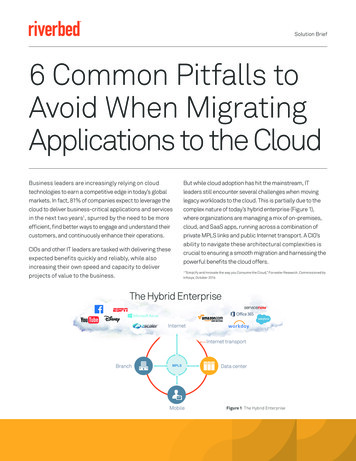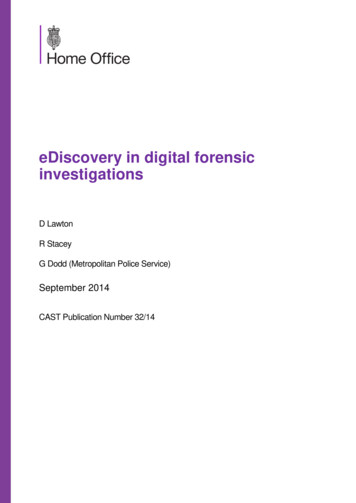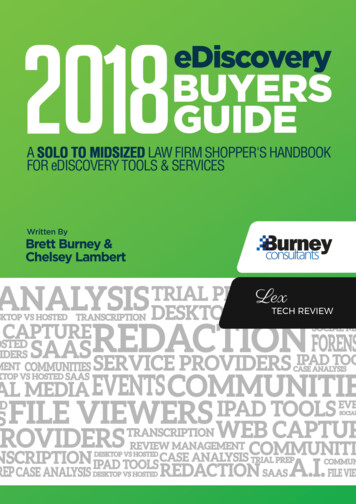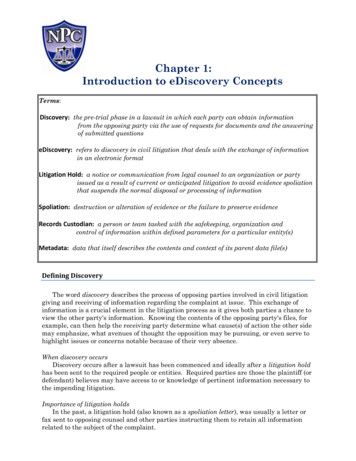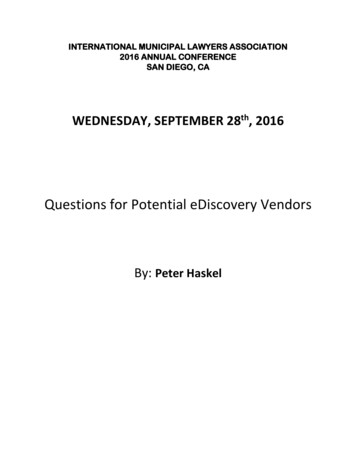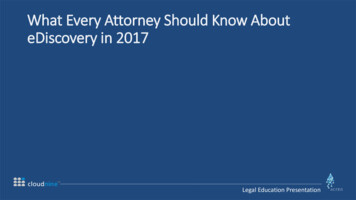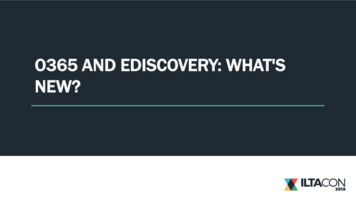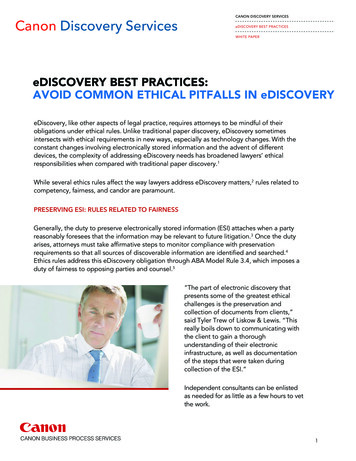
Transcription
CANON DISCOVERY SERVICESeDISCOVERY BEST PRACTICESWHITE PAPEReDISCOVERY BEST PRACTICES:AVOID COMMON ETHICAL PITFALLS IN eDISCOVERYeDiscovery, like other aspects of legal practice, requires attorneys to be mindful of theirobligations under ethical rules. Unlike traditional paper discovery, eDiscovery sometimesintersects with ethical requirements in new ways, especially as technology changes. With theconstant changes involving electronically stored information and the advent of differentdevices, the complexity of addressing eDiscovery needs has broadened lawyers’ ethicalresponsibilities when compared with traditional paper discovery.1While several ethics rules affect the way lawyers address eDiscovery matters,2 rules related tocompetency, fairness, and candor are paramount.PRESERVING ESI: RULES RELATED TO FAIRNESSGenerally, the duty to preserve electronically stored information (ESI) attaches when a partyreasonably foresees that the information may be relevant to future litigation.3 Once the dutyarises, attorneys must take affirmative steps to monitor compliance with preservationrequirements so that all sources of discoverable information are identified and searched.4Ethics rules address this eDiscovery obligation through ABA Model Rule 3.4, which imposes aduty of fairness to opposing parties and counsel.5“The part of electronic discovery thatpresents some of the greatest ethicalchallenges is the preservation andcollection of documents from clients,”said Tyler Trew of Liskow & Lewis. “Thisreally boils down to communicating withthe client to gain a thoroughunderstanding of their electronicinfrastructure, as well as documentationof the steps that were taken duringcollection of the ESI.”Independent consultants can be enlistedas needed for as little as a few hours to vetthe work.1
Communicating obligations to clients anddocumenting steps taken will protect clients fromspoliation claims, and fulfill an attorney’s ethicalobligations under Model Rule 3.4.6 Therefore,attorneys should take care to issue and monitorlitigation hold notices to their clients, no matterthe stage of litigation at which they are retained.Proper preservation requires that the collectionprocess include interviews with documentcustodians to ensure potentially relevant ESI ispreserved.7 “After an initial litigation hold hasbeen issued, custodian interviews should beundertaken to gain a better understanding of thelocation of all potentially relevant ESI,” Trew said.At a minimum, attorneys should make sure they’re able to implement, or cause to beimplemented, ESI preservation procedures; identify custodians of potentially relevant ESI;and produce responsive nonprivileged ESI in a recognized and appropriate manner.8 Oneway to do this is to take advantage of technical training offered by bar associations.CANDOR REQUIREMENT EXTENDS TO eDISCOVERYThe challenges related to the collection, processing, review, and production of ESI alsoimplicate the duties of candor to adversaries and the tribunal contained in Model Rule 3.3.9At times, the duty to zealously represent a client can seem to conflict with an attorney’s dutyto be a candid officer of the court.10“A key ethical issue is that attorneys cannot provide false or misleading representation,” saidJonathan Bick, chair of the patent, intellectual property, and information technology practiceat Brach Eichler, and professor of internet law at Pace Law School and Rutgers UniversityLaw School. “Likewise, attorneys must prevent clients from engaging in false and misleadingbehavior when it comes to electronic discovery.”Attorneys can appear to mislead parties by not having a proper understanding of key terms andprocesses related to the work. Engaging a consultant judiciously can assist in addressing this.Attorneys must be able to make accurate representations to adversaries and the tribunalabout their ability to produce ESI, the thoroughness of the searches and review performed,and the content of production sets to meet their obligations under Model Rule 3.4.As such, attorneys should be able to engage in a competent and meaningful meet-and-conferwith opposing counsel concerning an eDiscovery plan and collect responsive ESI in a mannerthat preserves the integrity of that ESI.112
ETHICS RULES ADDRESS COMPETENCE“The most basic ethical issue for lawyerswhen engaging in eDiscovery is the dutyof competent representation,” said KateG. Maynard, a litigator who serves asRobinson Bradshaw’s general counsel.The American Bar Association’s ModelRule 1.1 requires lawyers to providecompetent representation to theirclients.12Included in competence is therequirement that attorneys stay “abreast of changes in the law and its practice, including thebenefits and risks associated with relevant technology.”13 In 2012, Maynard said, Model Rule1.1, Comment 8 was revised to include not only the general requirement that lawyers bringrequisite knowledge and skill to matters they handle, but also an obligation to stay currenton technology.14In accordance with ABA Model Rules, most state bar associations are requiring technologicalcompetence from attorneys.15With respect to eDiscovery specifically, technical competence requires that attorneys have afirm grasp on not only their client’s email systems, but also other sources for relevant electronicinformation.Failing to understand a client’s ESI sources jeopardizes the ability to identify, preserve, andcollect relevant information, and risks the possibility that adversaries will claim spoliation.16This itself raises ethical issues with respect to an attorney’s duty.“Competent representation requires the ability to locate evidence to support or defend yourclient’s position,” Maynard said. “Lawyers must know where to look and how to ask the rightquestions to locate ESI, and must know how to take the necessary steps to preserve theevidence for use or production in the case.”Retaining experts in this area to confirm or challenge an understanding is a prudent and costeffective way to address this. Relying on personal knowledge or internal knowledge alone canlead to misunderstandings and discovery challenges.Attorneys must be able to do tasks such as assess eDiscovery needs, analyze and understand aclient’s ESI systems and storage, and perform data searches.173
CONCLUSIONComplying with ethics obligations related to competence requires attorneys to beknowledgeable about technology, especially client ESI, to avoid the imposition of sanctions ina litigation in chief, as well as in potential ancillary bar actions alleging attorney misconduct.Ethics obligations also require that attorneys follow rules related to fairness and candor, whilezealously representing their clients with respect to eDiscovery.“I don’t think it is necessary for every lawyer to know every technology inside and out—thatisn’t realistic,” Maynard said. But, “a lawyer does need to know how to ask the right questionsto locate relevant ESI, when preservation is necessary and how to preserve ESI effectively, andwhen to ask for help.”In fact, any attorney whose in-house team lacks the necessary expertise in any of these criticalareas should consider seeking a vendor that does have the expertise.Other steps that can help attorneys meet their obligations include: Understand the ethics obligations imposed by the authorities in your jurisdiction. Keep upwith ethics rulings and opinions related to technology and discovery.18 Understand the technologies and issues involved. Gain competency by taking classesoffered by bar associations regarding technology and eDiscovery or work withknowledgeable co-counsel or other experts. Regularly incorporate consultants andvendors into in-house training sessions and associate training. Understand what your discovery obligationsare, and when they arise, taking theappropriate steps such as issuing litigationholds, interviewing custodians, documentingactions, and monitoring the preservationwork of non-lawyers, including clients.19Articulate your discovery obligations as ifyou were explaining to a jury. Address theclarity and accuracy of your description inthe process. To the extent necessary, explain technologyand applicable practice and ethics rules toyour client, so he or she understands theparameters of discovery obligations.Taking those steps should go a long way to fulfilling ethics obligations when working witheDiscovery.4
ABOUT CANON DISCOVERY SERVICESCanon Discovery Services has a skilled, dedicated team of discovery professionals with aproven track record in solving complex discovery matters. Backed by over twenty years ofexperience, we help law firms and corporate legal departments develop practical, defensibleeDiscovery response plans to support successful outcomes. Our services range from ESIprocessing, culling and analysis, document review, hosting and production to implementinginformation governance and readiness response programs. Canon Discovery Services is a partof Canon Business Process Services, a subsidiary of Canon U.S.A. Visit us at cbps.canon.com.1Tyler D. Trew, “Ethical Obligations in Electronic Discovery,” Section of Litigation, American Bar Association, June 5, 2018, ne G. Maynard, “Ethical Obligations Arising in Electronic Discovery,” Litigation Article, Robinson, Bradshaw & Hinson, November 2007,p. 1, /514 article kmaynard ethical.pdf3Zubulake v. UBS Warburg, 220 F.R.D. 212 (S.D.N.Y. 2003)4Zubulake v. UBS Warburg, 229 F.R.D. 422 (S.D.N.Y. 2004)5American Bar Association, Model Rules of Professional Conduct, https://www.americanbar.org/groups/professional responsibility/publications/model rules of professional conduct/rule 3 4 fairness to opposing party counsel.html6Email correspondence from Tyler Trew, Aug. 22, 20187Tyler D. Trew, “Ethical Obligations in Electronic Discovery”8John A. Greenhall, Anthony L. Byler, and Kathleen M. Morley, “Attorney Ethical Duties in E-Discovery: It’s Important to StayCurrent,” The Legal Intelligencer, Feb. 8, 2018, citing Cal. Ethics Opinion 2015-193, 9American Bar Association, Model Rules of Professional Conduct, https://www.americanbar.org/groups/professional responsibility/publications/model rules of professional conduct/rule 3 3 candor toward the tribunal.html10Interview with Jonathan Bick, Pace Law School and Rutgers University Law School, Aug. 20, 201811John A. Greenhall, et al., “Attorney Ethical Duties in E-Discovery”12American Bar Association, Model Rules of Professional Conduct, ABA Rule of Professional Conduct 1.1: “A lawyer shall provide competentrepresentation to a client. Competent representation requires the legal knowledge, skill, thoroughness and preparation reasonably necessaryfor the representation.” https://www.americanbar.org/groups/professional responsibility/publications/model rules of professional conduct/rule 1 1 competence.html13Tyler D. Trew, “Ethical Obligations in Electronic Discovery”; quoting ABA Model Rue 1.1, cmt. 8, https://www.americanbar.org/groups/professional responsibility/publications/model rules of professional conduct/rule 1 1 competence/comment on rule 1 1.html14Email correspondence with Katherine G. Maynard, Aug. 28, 201815Caroline Grossweiler, “‘Technological Competence’: The Role Bar Associations Will Play in Explaining a Lawyer’s Duty of Competence withTechnology,” Journal of Law and Technology, University of Richmond, April 23, 2018, ology/16Tyler D. Trew, “Ethical Obligations in Electronic Discovery”17John A. Greenhall, et al., “Attorney Ethical Duties in E-Discovery,” citing Cal. Ethics Opinion 2015-19318California Ethics Opinion 2015-193, fn. 3, -15)%20-%20FINAL.pdf19Marie L. Mathews and Brigitte M. Gladis, “Ethical Considerations in E-Discovery: Avoiding Malpractice Claims,” New Jersey Law Journal, April11, 2018, citing Industrial Quick Search v. Miller, Rosado & Algois, 1:13-Civ-05589-ER (S.D.N.Y. Jan. 2, 2018) (holding that the law firm had anobligation to advice the client of its preservation obligation even though that obligation arose prior to the retention of the law firm) and Brownv. Tellermate Holdings, No. 2:11-cv-1122, 2014 WL 2987051 (S.D. Ohio July 1, 2014) (holding that the law firm had a duty to identify key personneland to actively participate with the client in preservation, search, and production), e-claims/This whitepaper is not intended to provide any legal advice. 2018 Canon Business Process Services. All rights reserved.5
eDiscovery, like other aspects of legal practice, requires attorneys to be mindful of their . questions to locate ESI, and must know how to take the necessary steps to preserve the evidence for use or production in the case.” . Interview with Jonathan Bick, Pace Law Sc
